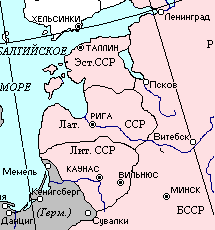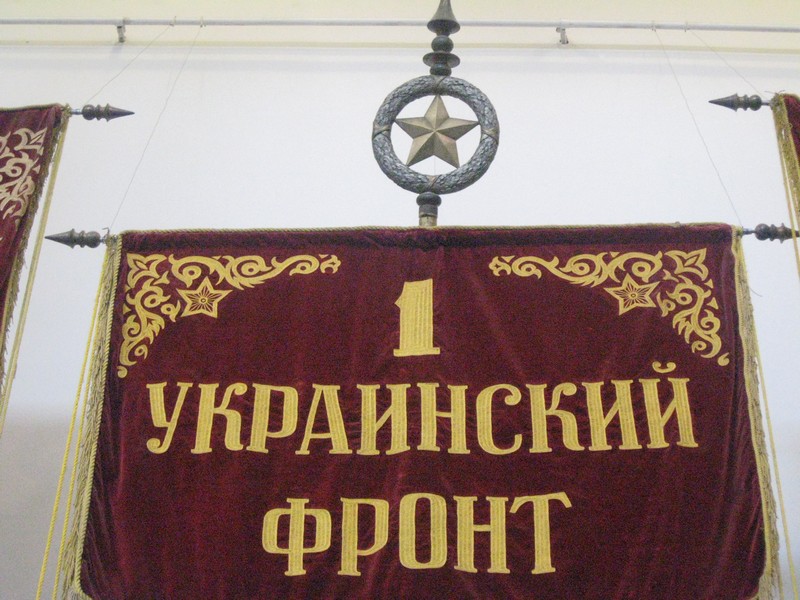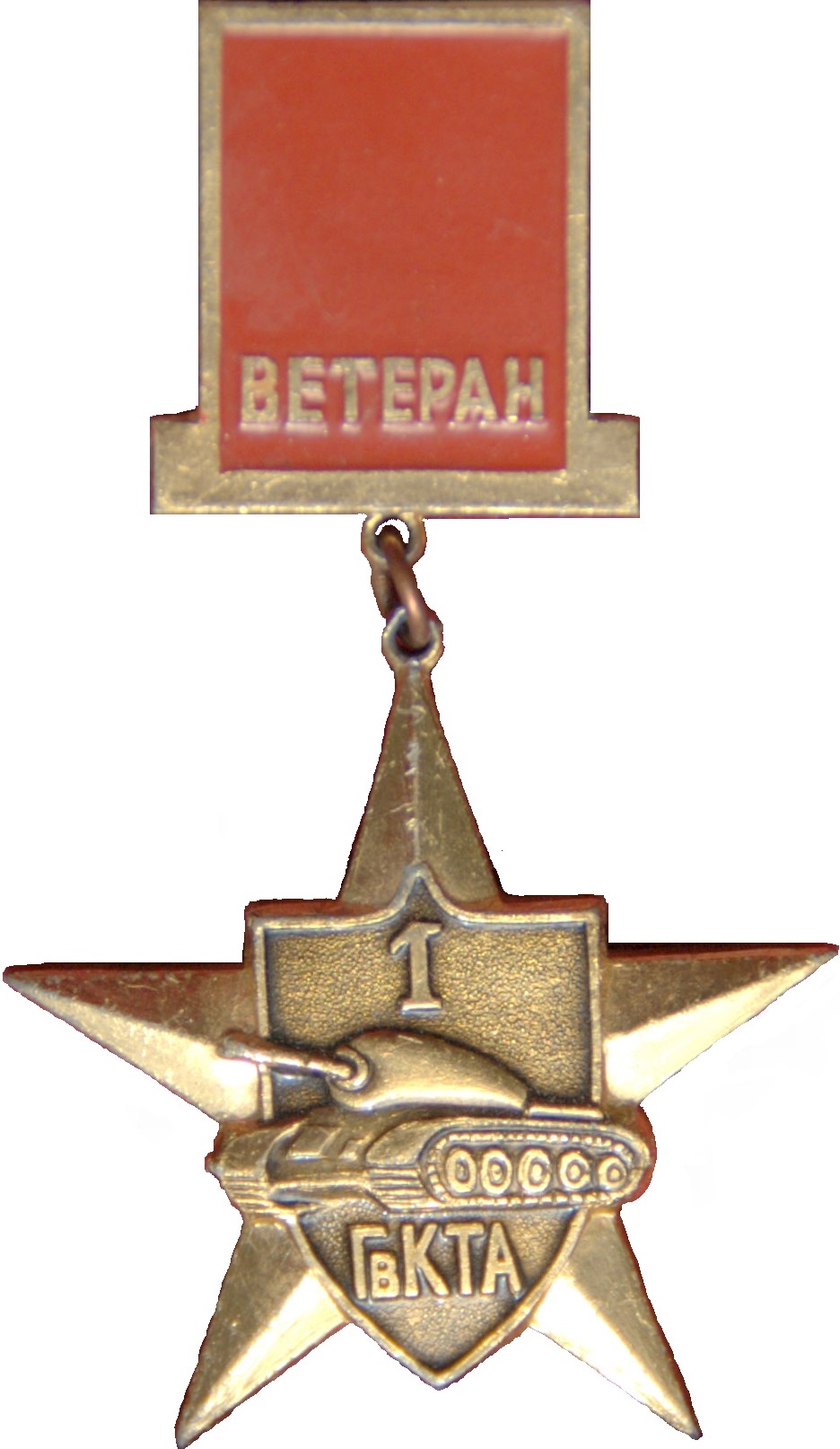|
38th Army (Soviet Union)
The 38th Red Banner Army was a field army of the Soviet Union that existed between 1941 and 1991. August 1941 to January 1942 The 38th Army was formed on 4 August 1941 after a large Soviet force had been surrounded by Axis forces in the area of Uman in the western Ukraine. Under the command of Lieutenant-General Dmitry Ryabyshev, 38th Army was based on the forces and headquarters of the 8th Mechanised Corps and incorporated other Soviet units then in the Cherkassy area. The army was subordinated to the Soviet Southwestern Front command, and Riabyshev's task was to defend the line of the Dnepr upriver from Kremenchuk, a task that became more urgent after the Soviet forces at Uman surrendered on 12 August and German forces began to close up to the Dnepr. On 30 August Riabyshev was assigned to command Soviet forces further south and Major-General Nikolay Feklenko was appointed to the command of 38th Army. By then 38th Army (based on seven rifle divisions, four cavalry divisions a ... [...More Info...] [...Related Items...] OR: [Wikipedia] [Google] [Baidu] |
Soviet Union
The Soviet Union,. officially the Union of Soviet Socialist Republics. (USSR),. was a transcontinental country that spanned much of Eurasia from 1922 to 1991. A flagship communist state, it was nominally a federal union of fifteen national republics; in practice, both its government and its economy were highly centralized until its final years. It was a one-party state governed by the Communist Party of the Soviet Union, with the city of Moscow serving as its capital as well as that of its largest and most populous republic: the Russian SFSR. Other major cities included Leningrad (Russian SFSR), Kiev (Ukrainian SSR), Minsk ( Byelorussian SSR), Tashkent (Uzbek SSR), Alma-Ata (Kazakh SSR), and Novosibirsk (Russian SFSR). It was the largest country in the world, covering over and spanning eleven time zones. The country's roots lay in the October Revolution of 1917, when the Bolsheviks, under the leadership of Vladimir Lenin, overthrew the Russian Provisional Government ... [...More Info...] [...Related Items...] OR: [Wikipedia] [Google] [Baidu] |
221st Rifle Division
The 221st Rifle Division was formed as an infantry division of the Red Army after a motorized division of that same number was redesignated about four weeks after the start of the German invasion of the Soviet Union. After several further redesignations the division, which had always been a rifle division for all intents and purposes, was destroyed during Operation Typhoon in October 1941. The first official 221st Rifle Division was formed in the spring of 1942 in the Ural Military District from a mix of several Central Asian nationalities. It arrived in Stalingrad Front in late August and was immediately thrown into the offensives that were attempting to break through the German corridor from the Don (river), Don River to the city in order to relieve 62nd Army (Soviet Union), 62nd Army. The Kotluban offensives were expensive failures and by the end of October the division was so badly depleted that it was disbanded. A new 221st was formed in 5th Shock Army of Southern Front (Sovie ... [...More Info...] [...Related Items...] OR: [Wikipedia] [Google] [Baidu] |
30th Rifle Division
The 30th Rifle Division was an infantry division of the Soviet Union, formed three times. The final full name of its first formation was the 30th Rifle Irkutsk Order of Lenin, three Orders of the Red Banner, Order of the Red Banner of Labour Division of the name of the Supreme Soviet of the RSFSR. After being redesignated the 55th Guards Rifle Division in December 1942, the Second Formation of the division was recreated at Rossosh in April 1943. The division was formed a third time in 1955. History Formed in October 1918 by the merger of the 3rd and 4th infantry divisions of the Ural as the 4th Ural Infantry Division, in November 1918 the division was renamed the 30th Rifle Division. Two senior Soviet military leaders served with the division in its early years; Vasily Konstantinovich Blucher, later famous for his commands in the Far East, commanded the division from 22 September 1918 to 15 January 1919, and Konstantin Rokossovsky, later Marshal of the Soviet Union, commanded ... [...More Info...] [...Related Items...] OR: [Wikipedia] [Google] [Baidu] |
11th Rifle Corps
The 11th Rifle Corps () was a corps of the Red Army, formed twice. The 11th was first formed in 1922 in the Petrograd area but soon moved to the Belorussian Military District. After fighting in the Soviet invasion of Poland, the corps moved to Lithuania, where it was stationed when Operation Barbarossa, the German invasion of the Soviet Union, began on 22 June 1941. Suffering heavy losses, the corps retreated through Lithuania and Latvia to Estonia in the Baltic Strategic Defensive Operation. It defended positions in Estonia in July and early August during the Leningrad Strategic Defensive before being disbanded that month when the Red Army abolished rifle corps. Reformed in October 1942 when the Red Army reestablished its rifle corps, the 11th fought in the Battle of the Caucasus for the next year. After the completion of the recapture of the North Caucasus, the corps fought in western Ukraine and the Carpathians. Ending the war in Czechoslovakia, it was disbanded in the summer ... [...More Info...] [...Related Items...] OR: [Wikipedia] [Google] [Baidu] |
4th Ukrainian Front
The 4th Ukrainian Front (Russian: Четвёртый Украинский фронт) was the name of two distinct Red Army strategic army groups that fought on the Eastern Front in World War II. The front was first formed on 20 October 1943, by renaming the Southern Front and was involved in the Lower Dnieper Strategic Offensive Operation, two battles of Kiev and the Crimean Strategic Offensive Operation. After the liberation of Crimea, the front was disbanded in May 1944. For the second time the 4th Ukrainian Front was created on 4 August 1944, by separating the left wing of the 1st Ukrainian Front. The front took part in the Carpathian Offensive simultaneously with the Battle of the Dukla Pass. Afterwards, the front was involved in the battles in East-, North- and Central Slovakia, as well as in the Moravian-Ostrava Offensive Operation on the Polish-Moravian borders and finally in the Prague Offensive which was the final battle of World War II in Europe. The actions of ... [...More Info...] [...Related Items...] OR: [Wikipedia] [Google] [Baidu] |
17th Army (Wehrmacht)
The German Seventeenth Army () was a field army of Nazi Germany during World War II. Operation Barbarossa On 22 June 1941, the 17th Army was part of Army Group South when Nazi Germany launched Operation Barbarossa and invaded the Soviet Union. From 1 July, the Hungarian "Mobile Corps" (''Gyorshadtest'') was subordinated to the 17th Army. Along with 1st Panzer Army, the 17th Army encircled Soviet forces in central Ukraine during the Battle of Uman. Approximately 100,000 Soviet troops were captured. The 17th Army participated in the Battle of Kiev. Army Group South was ordered to resume the offensive, with the objective of capturing Rostov-on-Don, the gateway to the Caucasus oil fields, and Kharkov, a major center of heavy industry for the Soviet Union. In October 1941, the army came under the command of Hermann Hoth, who was convicted post-war in the High Command Trial. Hoth was an active supporter of the war of annihilation (') against the Soviet Union. He called upon his men t ... [...More Info...] [...Related Items...] OR: [Wikipedia] [Google] [Baidu] |
1st Ukrainian Front
The 1st Ukrainian Front (Russian: Пéрвый Украи́нский фронт), previously the Voronezh Front (Russian: Воронежский Фронт) was a major formation of the Soviet Army during World War II, being equivalent to a Western army group. Background During the first months of the war, officers from 16 regions of Ukraine conscripted about 2.5 million people from military enlistment offices. 1.3 million militiamen from the left-bank and southern regions of Ukraine fought against the enemy. In 1941, about 3.185 million citizens of the Ukrainian SSR were sent to the Soviet Red Army and Navy. Replenishing mostly the units of the Southern and Southwestern fronts, the Ukrainian people formed the basis of the 37th, 38th, and 40th armies; and the 13th and 17th rifle divisions. Due to the conscription of civilians, the proportion of Ukrainian citizens fighting in south-west Ukraine reached 50%. This significantly exceeded the percentage of Ukrainians from t ... [...More Info...] [...Related Items...] OR: [Wikipedia] [Google] [Baidu] |
Bryansk Front
The Bryansk Front (russian: Брянский фронт) was a major formation of the Red Army during the Second World War. First Formation (August - November 1941) General Andrei Yeremenko was designated commander of the Front when it first formed in mid-late August 1941, comprising, in Erickson's words, "on paper two armies, 50th and 13th, with eight rifle divisions each, three cavalry divisions, and one tank division but many of these formations were badly whittled down by battle losses." Two other armies from Soviet Central Front, 21st and 3rd Army, which had avoided encirclement at the Battle of Smolensk (1941), were promised but also badly worn down. In late August along with the Western Front (Soviet Union) and the Reserve Front, the Bryansk Front launched a large but unsuccessful counteroffensive in the Smolensk, El'nia, and Roslavl regions to halt Army Group Centre's advance on Moscow. Despite some success by the Reserve Front at El'nia, the efforts by Bryansk Fro ... [...More Info...] [...Related Items...] OR: [Wikipedia] [Google] [Baidu] |
1st Guards Tank Army
The 1st Guards Tank Army () is a tank Field army, army of the Russian Ground Forces. The army traces its heritage back to the 1st Tank Army, formed twice in July 1942 and in January 1943 and converted into the 1st Guards Tank Army in January 1944. The army fought as part of the Red Army on the Eastern Front (World War II), Eastern Front during World War II. The army was commanded throughout most of the war by Mikhail Katukov. It fought in the early defense during the Battle of Stalingrad, and Operation Uranus, and participated in the Battle of Kursk, Kamenets-Podolsky pocket, Proskurov-Chernovtsy Operation, Lvov–Sandomierz Offensive, Lvov-Sandomierz Operation, Vistula–Oder Offensive, Vistula-Oder Offensive and the Battle of Berlin. After the war, the army was stationed in East Germany as part of the Group of Soviet Forces in Germany. After the end of the Cold War and the resultant withdrawal of Soviet units in Germany, the army was relocated to Smolensk, and disbanded in ... [...More Info...] [...Related Items...] OR: [Wikipedia] [Google] [Baidu] |




